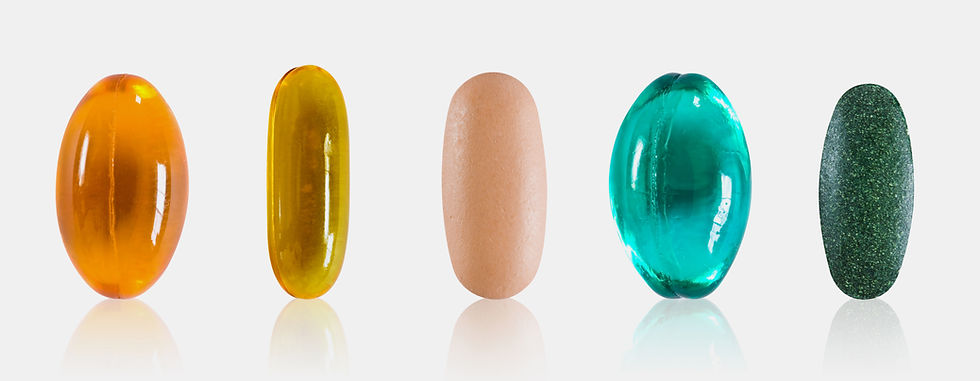Why You Might Be Vitamin D Deficient (Even in the Summer)—and How to Fix It
- Dr. Amy Gueye

- May 20
- 3 min read
Intro
We often associate vitamin D with sunshine and strong bones, but the truth is, this essential
nutrient functions more like a hormone, playing a powerful role in your immune system,
energy levels, mental health, fertility, and hormone balance.
Yet millions of women are unknowingly deficient, even those who spend time outside. And
for black and brown women, the risk is even higher due to increased melanin, which
naturally blocks vitamin D synthesis in the skin.
If you’ve been feeling low energy, anxious, foggy, or having irregular periods or immune
issues, a vitamin D deficiency may be silently contributing to your symptoms.
Let’s break down why it matters, how to spot it, and—most importantly—how to fix it
naturally.
Why Vitamin D Is So Important for Women
Vitamin D is involved in over 1,000 processes in the body. It helps.
- Regulate estrogen, progesterone, and testosterone
- Reduce PMS, PCOS, and perimenopausal symptoms
- Support bone health and prevent osteoporosis
- Strengthen the immune system
- Improve mood and reduce risk of depression and anxiety
- Lower the risk of autoimmune disease and cancer
Why Are So Many Women Deficient?
• Limited sun exposure: Office jobs, sunscreen, or long winters block UVB rays.
• Darker skin tones: More melanin = more protection from UV, but also lower vitamin D
production.
• Gut or liver issues: Poor absorption or detoxification can interfere with vitamin D
activation.
• Obesity or high body fat: Vitamin D gets sequestered in fat tissue and becomes less
available in the bloodstream.
• Aging: The skin becomes less efficient at converting sunlight to vitamin D over time.
Symptoms of Vitamin D Deficiency
You might be low in vitamin D if you experience:
- Low energy or fatigue
- Brain fog or memory issues
- Mood swings, depression, or anxiety
- Frequent colds or infections
- Bone or muscle aches
- Hormonal imbalance, PMS, or irregular cycles
- Hair thinning or loss
How to Know Your Vitamin D Levels
Ask your provider for a 25-hydroxyvitamin D [25(OH)D] blood test. This is the most
accurate way to assess your levels.
- Optimal range: 40–70 ng/mL
- Deficiency: Less than 30 ng/mL
- Severe deficiency: Less than 20 ng/mL
Note: Always recheck levels after 8–12 weeks if you begin supplementation.
5 Powerful Ways to Boost Your Vitamin D Levels
1. Get Intentional Sunlight
- Aim for 15–30 minutes of midday sun (10 a.m. to 2 p.m.) on your arms, legs, or back
without sunscreen.
- Do this 3–5 times per week, depending on your skin tone and location.
2. Use the Right Supplement (D3 & D2)
- Look for vitamin D3 (cholecalciferol), not D2.
- General guideline: 2,000–5,000 IU daily
- Higher doses (10,000 IU) may be used short-term for those with severe deficiency
(under supervision).
- Take it with food containing fat to boost absorption.
3. Pair With Vitamin K2 and Magnesium
- Vitamin K2 (MK-7) directs calcium into your bones.
- Magnesium is required for vitamin D to be metabolized properly.
4. Eat Vitamin D–Rich Foods
- Wild-caught salmon, sardines, mackerel
- Pasture-raised egg yolks
- Mushrooms exposed to UV light
- Fortified foods (almond milk, orange juice, cereals)
5. Heal Your Gut and Liver
- If you’ve had IBS, SIBO, liver disease, or gallbladder issues, your absorption or
Conversion may be impaired.
- Support gut health with probiotics, enzymes, and anti-inflammatory foods.
- Support the liver with bitter greens, milk thistle, and hydration.
Vitamin D and Hormones—What’s the Connection?
Vitamin D acts on the hypothalamus and pituitary glands, which regulate your reproductive
hormones. Deficiency has been linked to:
- Increased PMS symptoms
- Worse PCOS outcomes
- Low testosterone and low libido
- More severe perimenopausal transitions
- Infertility in both men and women
Final Takeaway
Vitamin D is one of the most overlooked hormone regulators in women’s health. Whether
you’re struggling with fatigue, mood changes, menstrual issues, or immune weakness,
Getting your vitamin D levels optimized can be a game-changer.
Action Steps:
- Ask for a 25(OH)D test
- Start with 2,000–5,000 IU of D3 daily
- Pair with K2 and magnesium
- Recheck your levels every 3–6 months
- Use sunlight as medicine—intentionally and safely
Your health is in your hands—and this simple shift could be the first domino in restoring
your vitality.



Comments